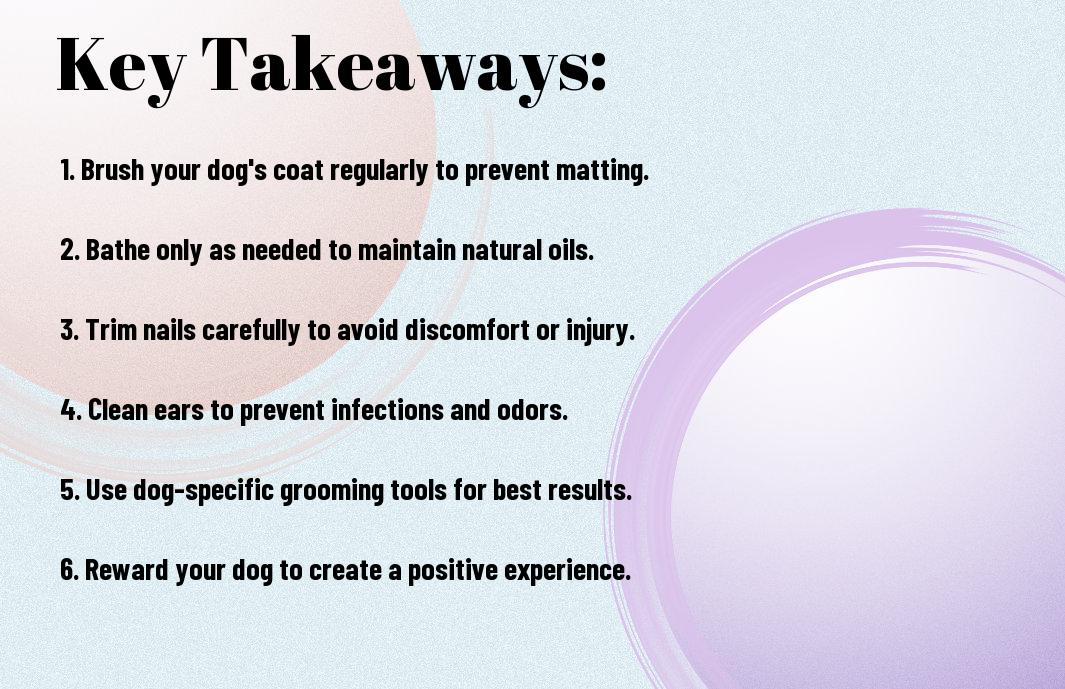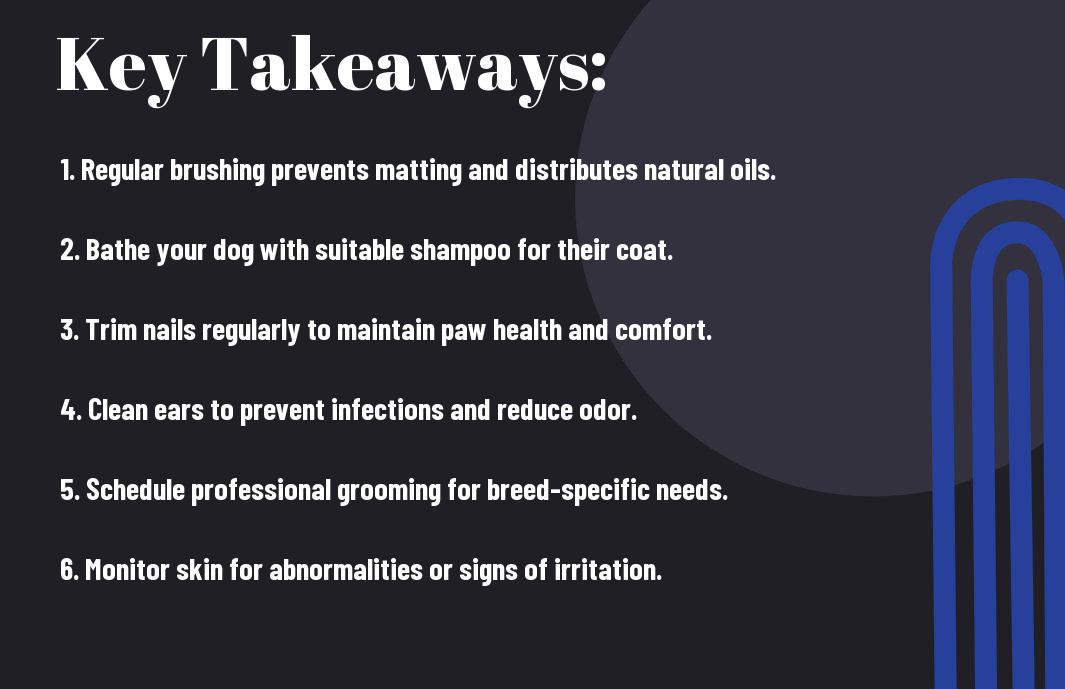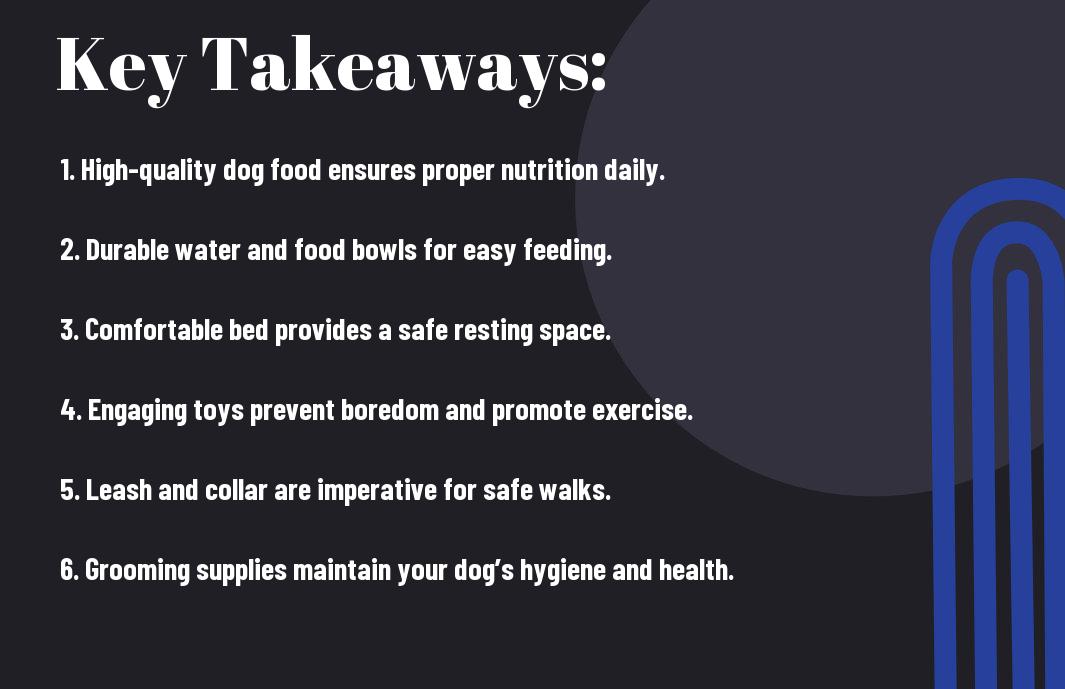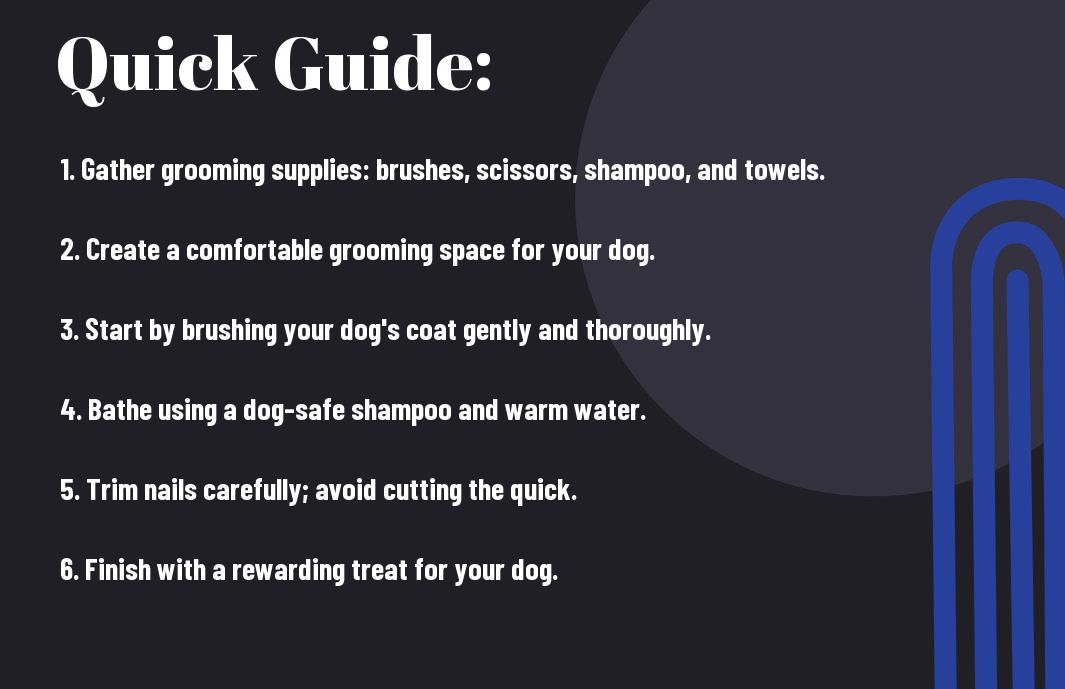Tips for dog grooming at home are vital for maintaining your furry friend’s health and happiness. Regular grooming not only helps keep your dog’s coat clean and free from mats but also allows you to check for any skin issues or parasites. In this post, you’ll discover ten practical strategies that will simplify the grooming process and strengthen your bond with your pet. With the right techniques and tools, you can make at-home grooming a rewarding experience for both you and your dog.

Gather Necessary Grooming Tools
Your dog’s grooming routine can be simplified significantly by gathering the right tools before you start. Having everything you need at hand ensures a smoother experience for both you and your furry friend. Whether you’re dealing with a short-haired breed or a long-haired one, having the correct equipment can make all the difference in achieving a professional finish in the comfort of your home.
Brushes and Combs
Any dog owner understands the importance of keeping their pet’s coat healthy and free from matting. Investing in a good set of brushes and combs is crucial, as different breeds and coat types require different grooming techniques. For example, slicker brushes are ideal for removing tangles in long-haired breeds, while bristle brushes are more suitable for short-haired dogs. Meanwhile, a metal comb can help you navigate through the fur for additional grooming precision, especially in sensitive areas.
Furthermore, using the right brush not only helps in maintaining your dog’s coat but also stimulates the skin and distributes natural oils, which can promote a healthy and shiny appearance. Regular brushing can also reduce shedding, which is a bonus for keeping your home cleaner.
Nail Clippers
You will want to pay particular attention to your dog’s nails, as overgrown nails can lead to discomfort and potential health issues. Nail clippers come in various designs, including guillotine-style, scissors-style, and electric grinders, so you can select the one that best suits your comfort and your dog’s needs. It’s crucial to choose clippers that are sharp and easy to handle to ensure a quick and effective trimming process.
Using the right nail clippers not only helps to keep your dog’s paws healthy but also minimizes the risk of pain or injury during the trimming process. It’s important to get your dog used to having their nails trimmed from an early age to make the task easier in the future. Also, be mindful of the quick, which is the pink area within the nail that contains blood vessels. Cutting too close can cause bleeding, so take your time and trim gradually, especially if your dog isn’t accustomed to the process.
Choose a Suitable Grooming Area
There’s a lot to consider when selecting an appropriate grooming area for your dog. The environment plays a significant role in how comfortable and cooperative your pet will be during the grooming process. By creating a suitable area, not only do you set the stage for a successful grooming experience, but you also make it more enjoyable for both you and your furry friend.
Quiet and Comfortable
One of the first factors to keep in mind is the noise level of the environment. A quiet space allows your dog to feel relaxed and at ease, minimizing the chances of anxiety or agitation during grooming. You might want to choose a room away from loud appliances, such as washing machines or vacuums, as well as from high-traffic areas where sudden movements or sounds could startle your pet. Ensure the area is comfortable, making it a stress-free experience for both of you.
Additionally, consider the temperature of the room. A space that is too hot or too cold can make your dog uncomfortable and distract them from the grooming process. A well-ventilated area that maintains a comfortable temperature will enhance your dog’s grooming experience, allowing them to stay calm and focused, which helps you do your job effectively.
Non-slip Surface
Any grooming area should feature a non-slip surface to help prevent accidents. Grooming can make your dog fidgety, and a slippery floor can increase the likelihood of them losing their footing and potentially hurting themselves. To create a safe environment, opt for materials such as rubber mats or rugs that can provide traction when your dog moves around on them.
Surface options shouldn’t just be functional; they should also be easy to clean. Consider using washable pet grooming pads or mats to catch any loose fur and debris, ensuring your grooming area stays hygienic and tidy. This makes the grooming process smoother for you and allows you to focus more on getting your dog looking their best.
Brush Your Dog Regularly
All dogs benefit from regular brushing, as it not only helps keep their coat looking great but also promotes overall skin health. By incorporating this practice into your grooming routine, you can effectively manage shedding and maintain the quality of your dog’s coat. Brushing your dog on a consistent basis will enhance the bond you share and make grooming a much more enjoyable experience for both of you.
Remove Loose Hair
On a regular basis, brushing your dog is necessary for removing loose hair that accumulates in their coat. Whether your dog has short or long hair, a good brush can capture shedding fur before it ends up all over your home. Using the right brush designed for your dog’s coat type will make this task not only easier but more effective, allowing you to keep your living environment tidy while ensuring your dog feels comfortable.
Prevent Matting
Regular grooming is key to preventing matting, particularly for those breeds with longer or thicker fur. When you brush your dog frequently, you reduce the chance of tangles forming, which can lead to painful mats that may require professional removal. Taking the time to brush your dog in smaller sections will help you catch knots before they become serious problems and keep your pet comfortable.
It’s beneficial to establish a routine where you brush your dog at least a few times a week. During these sessions, pay close attention to areas prone to matting, such as behind the ears, under the legs, and around the collar area. If you do spot any mats, it’s best to use a dematting tool or scissors designed for this purpose to carefully remove them without pulling on your dog’s skin. Your attention to these details will keep your dog’s coat healthy and free from discomfort.

Bathe Your Dog Occasionally
Not all dogs require frequent bathing, as overdoing it can strip their coat of natural oils, leading to dry skin and irritation. Generally, a bath every few months is sufficient for most breeds, depending on your dog’s lifestyle, coat type, and any skin sensitivities. Wet, muddy, or particularly smelly dogs may need a bath sooner, but always pay attention to your dog’s unique needs when it comes to grooming practices.
Use Dog-Specific Shampoo
To maintain the health of your dog’s coat and skin, it’s imperative to use dog-specific shampoo. Human shampoos can be too harsh for your dog’s skin and may lead to allergies or irritation. Look for gentle, hypoallergenic options that are designed specifically for dogs, and consider your dog’s specific needs—whether they have sensitive skin, a particular coat type, or even flea and tick challenges.
Rinse Thoroughly
Any leftover shampoo residue can cause skin issues, so it’s crucial to rinse your dog thoroughly during bath time. After applying the shampoo and lathering up, ensure that you wash out all the product from your dog’s coat. It may take a bit of time, but a quick rinse can lead to skin irritation, leaving your dog uncomfortable for days.
This step is critical, particularly in areas where your dog may have thick fur. Rinsing well ensures that no product remains trapped in their coat, which can lead to discomfort, dryness, or even allergic reactions. After rinsing, you may want to towel dry your dog, taking care to remove excess water without causing irritation to their skin.
Trim Nails Carefully
Unlike many grooming tasks, trimming your dog’s nails requires a careful approach to ensure their comfort and safety. It’s important to get your dog accustomed to having their paws handled at an early age. You can make the process easier by incorporating nail trimming into your regular grooming routine. Take your time, and don’t rush it; this will help your dog feel more at ease and less anxious during the process.
Avoid Cutting Quick
For successful nail trimming, an necessary part is to avoid cutting the quick, the pinkish area inside the nail that contains blood vessels and nerves. Cutting into the quick can cause pain and bleeding, making your dog fearful of nail trimming in the future. To prevent this, familiarize yourself with your dog’s nails and look for the distinction between the quick and the nail tip. If your dog has dark nails where it’s difficult to see the quick, trim small bits at a time until you see light color in the nail, indicating you’re approaching the quick.
Use Sharp Clippers
One of the best ways to ensure a clean and efficient trim is to use sharp dog nail clippers. Dull clippers can crush the nail instead of making a clean cut, which may not only cause discomfort but can also frighten your dog. Invest in quality clippers that are comfortable for you to handle and suitable for your dog’s size—scissor-type, guillotine-type, or electric clippers are all viable options depending on your preference.
Plus, sharp clippers can help make the process quicker and less stressful for both you and your dog. A smooth cut minimizes discomfort and allows you to finish the grooming session more efficiently, reducing the likelihood of your dog becoming anxious. Regularly check the blades of your clippers and replace them when necessary to maintain optimal performance. By prioritizing sharp tools, you ensure that the nail trimming experience is as pleasant as possible for your furry friend.

Clean Ears Gently
Now, cleaning your dog’s ears is an imperative part of their grooming routine. Proper ear care helps prevent infections and keeps your dog’s ears healthy. Start by checking for any dirt or debris trapped in your dog’s ears before applying any cleaning solution.
Check for Dirt
Check the outer ear for dirt, wax buildup, or any signs of irritation. If you notice excessive wax or a foul smell, that could indicate a problem that needs addressing. Use a soft cloth or cotton ball to gently wipe the visible areas of the ear, being careful not to insert anything deep into the ear canal.
Keep an eye out for signs of discomfort as you inspect their ears. If your dog shows any signs of pain, such as shaking their head or scratching at their ears, it may be time to consult your veterinarian. Regular checks help you stay informed about your dog’s ear health and can prevent more serious issues down the line.
Use Vet-Recommended Cleaner
Assuming you have cleared the outer parts of your dog’s ears, the next step is to use a cleaner that your veterinarian recommends. It’s important to use a gentle solution specifically designed for canine ears, as some human products can be harmful. Follow the instructions provided with the cleaner for best results, usually applying a small amount directly into the ear canal and gently massaging the base of the ear.
A veterinarian-recommended ear cleaner is formulated to help dissolve wax and debris safely. Always ensure that you are using the product as directed to minimize any risk of irritation or discomfort for your dog. Make ear cleaning a positive experience by offering treats and praise, so your furry friend associates this routine with something enjoyable.
Dry Your Dog Properly
For effective dog grooming at home, drying your furry friend properly is just as important as giving them a good bath. A well-dried dog not only feels more comfortable but also maintains healthy skin and a shiny coat. Choosing the right method for drying can make the process smoother for both you and your dog.
Use Towels or Dryer
The first step in drying your dog is to use towels or a dog dryer to absorb excess water. Begin by gently rubbing your dog down with a large, absorbent towel, focusing on areas where water tends to pool, like the belly, behind the ears, and under the legs. Avoid aggressive rubbing, as this can irritate your dog’s skin or tangle their fur. If your dog is comfortable with it, you can also use a pet-specific dryer, which is designed to blow warm air without being too hot or noisy.
When you opt for a dryer, make sure you hold it at a safe distance from your dog’s body to prevent any discomfort. Use the lowest heat setting and keep the nozzle moving to ensure that you are not concentrating heat on one spot for too long. This will help dry your dog more effectively while ensuring they remain calm throughout the process.
Avoid Overheating
Little dogs, like small breeds, can become overheated quickly due to their size, making it important to monitor their comfort levels during the drying process. Larger breeds may also struggle with excess heat, so regardless of your dog’s size, it’s important to be cautious. Keep an eye on your dog for signs of distress, such as panting, restlessness, or avoidance behaviors, which can indicate discomfort as they dry off.
It’s wise to choose the environment carefully when drying your dog. Ensure the space is well-ventilated and that you are using a dryer specifically designed for pets. Always keep a close watch on your dog during the drying process, and if the room is warm, consider providing a cooler environment or drying them in shorter intervals. This way, you can maintain their comfort and safety while you groom them at home.
Inspect Skin and Coat
Many dog owners overlook the importance of regularly inspecting their dog’s skin and coat. This simple practice not only helps you identify potential health issues but also strengthens the bond you share with your pet. While grooming, take the time to examine your dog’s body and pay attention to their coat condition and skin health. This can provide you with valuable insights into their overall well-being.
Look for Irritations
If you notice any redness, bumps, or unusual patches on your dog’s skin, it is important to act accordingly. Skin irritations can be caused by various factors, including allergies, insect bites, or infections. Observing these signs early can lead to prompt treatment and may prevent more severe issues from arising. Make it a habit to check areas that are often overlooked, such as the belly, groin, and inside the ears.
If your dog’s coat appears dull or dry, this can also be an indication of underlying health issues. Pay attention to any excessive shedding or changes in coat texture, as these might signal dietary deficiencies or skin conditions. Regular checks will help you catch these potential problems early, leading to happier and healthier pets.
Monitor for Fleas
Any signs of fleas on your dog can lead to a frustrating experience for both you and your furry friend. Fleas are common parasites that can cause discomfort and health issues if left untreated. During your grooming sessions, keep an eye out for flea dirt, which looks like small black specks on your dog’s coat or skin. It’s important to check thoroughly, particularly in areas like the base of the tail and around the ears.
You can use a fine-toothed comb during your grooming routine to help detect fleas more easily. If you find fleas or flea dirt, it’s important to consult with your veterinarian about the best treatment options to eliminate them and prevent future infestations. Additionally, keeping your dog’s environment clean and regularly washing their bedding and toys can also help reduce the risk of fleas returning. Regular monitoring ensures your dog remains comfortable and free from these pesky pests.
Reward Your Dog
Once again, reinforcing positive behavior is key when it comes to dog grooming at home. Providing rewards can make grooming sessions smoother and more enjoyable for both you and your furry friend. When your dog feels encouraged, they are likely to associate grooming with positive experiences, making each subsequent session easier. This approach reduces the chances of resistance and fear, allowing your dog to feel more comfortable and relaxed during grooming.
Use Treats and Praise
The first step in rewarding your dog during grooming is to utilize treats and praise effectively. Treats should be small, bite-sized, and enticing enough to motivate your dog to behave well during each grooming task. As you perform each grooming activity—whether it’s brushing, nail trimming, or bathing—offer a treat after completing a stage of the process. This immediate reward helps your dog understand that good behavior yields positive outcomes, encouraging them to remain still and calm.
Alongside treats, don’t underestimate the power of verbal praise and affection. Your tone should be enthusiastic and soothing, making your dog feel accomplished. Phrases like “Good boy/girl!” can reinforce their good behavior and create an enjoyable atmosphere. When your dog associates praises and treats with grooming, they will be more willing to participate in the process.
Make Grooming Enjoyable
Your goal in grooming should extend beyond just maintaining your dog’s coat; it should also be about creating a positive experience. Start by establishing a comfortable space where grooming takes place, such as a designated area in your home that is free from distractions. Introduce your dog to the grooming tools gradually and allow them to sniff and explore them. This familiarity not only reduces anxiety but also helps your dog feel secure.
Praise and rewards can be used to enhance the grooming experience significantly. Incorporate play and bonding time between grooming steps—whether it’s a quick game with their favorite toy or a cuddle break. By intertwining these enjoyable elements with grooming, you transform what could be a stressful task into a fun, positive experience that your dog will actually look forward to.
Conclusion
Presently, you should feel empowered to take charge of your dog’s grooming needs at home with the ten vital tips provided. Implementing these practices will not only maintain your pet’s hygiene and appearance but also enhance the bond you share with them. Whether it’s regular brushing to prevent matting, giving proper baths, or ensuring nail trims are done correctly, you have the tools necessary to make your dog look and feel their best. Quality grooming is a critical part of your dog’s health and well-being, and doing it yourself can save time and money while building a stronger connection with your furry friend.
Your commitment to proper dog grooming practices at home reflects your dedication to your pet’s overall health. As you apply what you’ve learned, you’ll likely notice improvements not just in your dog’s physical appearance but also in their behavior and happiness. So, embrace the journey of grooming your dog with confidence, knowing that you’re contributing to their comfort and health. Regular grooming is a gift you give to your pet, and the positive impact it has will be evident in their wagging tails and joyful demeanor.
Q: What are the key tools needed for dog grooming at home?
A: To effectively groom your dog at home, it’s important to have the right tools on hand. Key grooming supplies include a high-quality brush suitable for your dog’s coat type (such as slicker brushes for long-haired dogs), nail clippers or a nail grinder, dog shampoo that is pH balanced for canines, a comb, and towels. Additionally, consider having a grooming apron to keep your clothes clean and a sturdy table or designated area to groom your dog comfortably.
Q: How often should I groom my dog at home?
A: The frequency of grooming depends on your dog’s breed, coat type, and individual needs. Generally, dogs with long or thick coats may require grooming every few weeks to prevent matting, while short-haired breeds might only need grooming once a month. Regular brushing helps remove loose fur and debris, keeping your dog’s coat and skin healthy. Additionally, checking and cleaning ears, teeth, and nails should be part of your grooming routine to maintain overall hygiene.
Q: What is the best way to introduce my dog to grooming at home?
A: Introducing your dog to grooming should be a gradual process to ensure they feel comfortable and relaxed. Start by allowing your dog to sniff and explore the grooming tools before using them. Begin with short grooming sessions, such as gentle brushing or nail trimming, and gradually increase the duration as your dog becomes more accustomed. Providing treats, praise, and breaks during the grooming process can create a positive association, making future grooming sessions easier and more enjoyable for both you and your dog.










